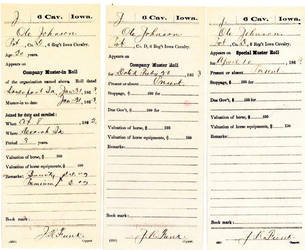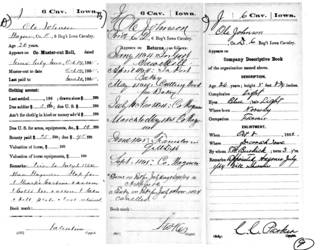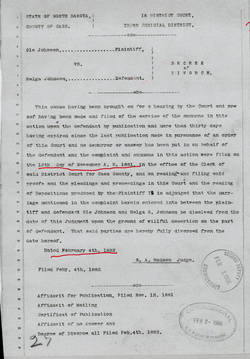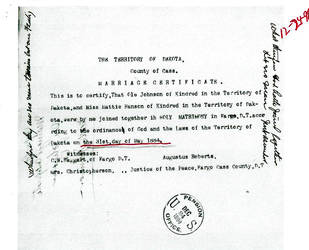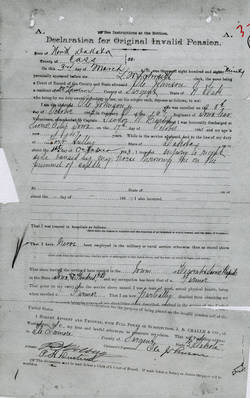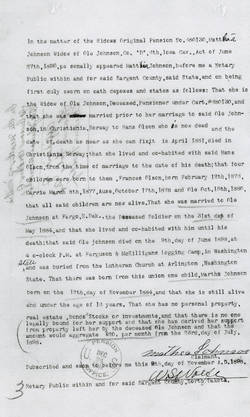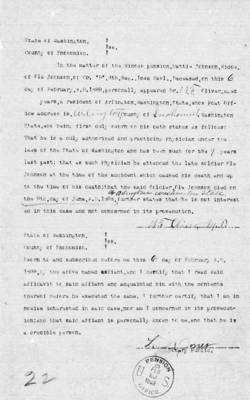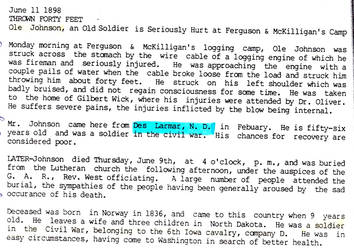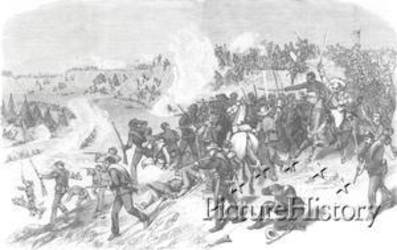Ole Johnson
Representing: Union
G.A.R Post
- E. M. Stanton Post #86 Arlington (Haller City), Snohomish Co. WA
Unit History
- 6th Iowa Cavalry D
Full Unit History
6th IOWA VOLUNTEER CAVALRY
Organized: 1862
Mustered In: 1/31 - 3/5/63 Davenport, IA
Mustered Out: 10/17/65
Regimental History
REGIMENTAL HISTORY:
The 6th was a three year western regiment. It spent its entire existence pursuing and conflicting with Native Americans in what was then considered America's "northwest." Recruited from a wide belt throughout the State of Iowa, the unit was formed in response to hostile Indian attacks which had been plundering and causing bloodshed in Minnesota.
The regiment, nearly 1200 strong, departed Iowa not long after its final March, '63 company muster. From that time onward, it had hard marches, far away from the comforts of civilization; fought barbarous foes - perhaps most importantly at the battle of Whitestone Hill in the Dakota Territory - in what is present-day Dickey County, North Dakota. Usually always outnumbered, the sixth was always victorious.
The unit was nearly always more or less divided, garrisoning, different posts, scouting and marching in different directions. As such, creating a succinct history of its exploits was considered almost impossible. What is succinctly known, however, is that the troopers of the 6th never fired a shot at Johnny Reb.
Regimental losses: 1 officer killed or mortally wounded; 1 officer died of disease, accidents, etc.; 21 enlisted men killed or mortally wounded; 74 enlisted men died of disease, accidents. etc.
Soldier History
SOLDIER
Residence: Decorah, Winneshiek Co., IA Age: ca. 26 yrs.
Enlisted/Enrolled: 10/8/62 Rank: Pvt.
Mustered In: 10/25/62 Decorah, IA or 1/31/63 Davenport, IA
Mustered Out: 10/17/65 Sioux City, IA
Highest Rank: Wagoner/Artificer
Family History
PERSONAL/FAMILY HISTORY:
Ole Johnson was born in Norway. Beyond this, little is clear in terms of his origins. No date of birth is provided in available documentation. As far as year of birth, one source points to 1836. Pension documents contain only one reference to year of birth and that is 1843. Information contained in military service records is inconclusive. If, however, one accepts as fact that his enlistment paper indicates he was twenty six years of age, then his year of birth was, in fact, ca. 1836. Exceptional proof to the contrary, it is this year that is being accepted herein.
1844/1845. It was during this period, reportedly ca. age nine, Ole came to America from Norway. Did he come with his parents? While no such documentation is available, such was likely the case. Names of his mother and father, however, are not documented.
Birth family siblings. According a 1907 document, Ole's then-widowed wife noted that he had two brothers. One - Peter living in Iowa and two - Christ (ian)- who was then residing in South Dakota. She also reported Ole had two sisters, whom she never saw and whose names she did not know. The U.S. Census of 1860, however, notes that the Salo Alverson family of Springfield Winneshiek Co. Iowa (post office Decorah) had two Johnsons living under their roof - Ole (b. Norway, 1839, laborer) and Mary (b. l836 Norway). Was this Ole and one of his sisters? Perhaps, but if this was him here is another possible birth year to his list. We will likely never know with certainty.
On 10/8/62 Ole, then residing in Decorah Winneshiek County, Iowa enlisted for three years in Captain F.W. Burdick's Company of cavalry which subsequently became company "D" of the 6th Iowa cavalry. For enlisting he received a bounty (bonus) of $100, $25 of which was paid up front with the remainder to come later. He also garnered a $2 "premium. At enlistment the 26 year old farmer's vital statistics were noted as 5' 8 3/4" in height, blue eyes, light complexion and light hair.
On 12/7/62, not long after becoming a soldier, Private Johnson was admitted to his regimental hospital with a case of the measles. He was returned to duty three days later. Medical issues continued to plague him into 1863 with two February "no diagnosis" contacts with the medical department noted in his records.
Continuing further into the year of 1863, in October, while stationed at Ft. Sully in the Dakota Territory (present day South Dakota), Ole's horse fell on him injuring his right side. The injury apparently must not have been considered that serious at the time as he did not require hospitalization. Not long thereafter, however,- in November or December - he reportedly contracted rheumatism from "laying out in the snow and rain."
Ole's medical woes continued into the year of 1864 when, in early February, he was admitted to the post hospital because of a fractured big toe. In this instance he was not returned to duty until the eleventh day of March.
In May/June Private Johnson was reported as being present for duty, but away from his unit cutting wood. In July he was appointed to the position of wagoner in the quartermaster department. For this appointment he was awarded a pay increase of $4 per month. While he would maintain this status throughout the remainder of the war, in mid-1865 his title was augmented by his becoming an artificer - a soldier skilled in mechanics who repaired wagons, etc.
On October, 17, 1865 Ole Johnson was separated from the service. At that time he was due $5.03 in pay and the remaining $75 of his enlistment bounty. He owed the U.S. Government $19 for arms and equipment. Apparently he somehow could not account for one Sharps carbine, one Colt revolver (and accoutrements) as well as one saber and beltplate. ...........
**************************************************
Military life behind him Ole returned to Iowa. Exactly where, however, is unclear as there is at least one documental reference to him living in Sioux City for a time. Likely, though, it was to Decatur as it was there in the home of Isaac Hank and family that the U.S. Census of 1870 found him. Likely he was a hired hand on the Hank farm.
On some unknown date after 1870, in Buena Vista County, Iowa Ole married Norwegian born Helga C.(or O) Brown. (In Norway it appears her surname was Oen because that was the name of the farm where she lived.) The couple then took up farming. Although Helga was reportedly a great deal older than Ole, the union would produce two daughters - Julia M. and Annie H. While the girls' birth years are not known, apparently they came into this world prior to 1878 as that was the year when Ole and Helga separated. (Note: at one point Ole had confided to a neighbor that he had a great deal of trouble with her and that his life was burdened because she was so jealous.) As part of the separation agreement Helga received the real estate, the house, furniture, two cows, two calves, about 23 head of sheep and 15 pigs. She would also be responsible for the care and protection of the couples' two minor children. Ole received all the other family assets either real or personal. To this agreement Ole signed his name. Helga made her X.
After separating from Helga it appears Ole made his way into the Dakotas. While there is no census information on him for 1880, the final months of 1881 found him in Cass County, Dakota Terr. It was there a divorce decree was filed - alleging desertion on the part of the defendant (Helga). The divorce of Ole and Helga was final as of 2/4/82.
A little more than two years after being granted his divorce decree, Ole remarried. On 5/31/84 in Fargo, Dakota Terr. he wed the previously married Mathea - "Mattie", later Matilda - (no nee) Olson. (b. 10/22/48 [other years given are 1847 and 1849, but in last decades of her life she would note in the census tallies that her year of birth was, in fact, 1848 in Norway).
In the fall of 1875 in Christiana Norway Mathea had married one Han Olson. She bore Han four children; three daughters Carrie (3/8/77), Frances (2/22/78), Hosea/Ause (10 or 11/17/78) and one son, Ole (No b.d.). In 1881 the family sold everything in preparation of moving to the U.S. Mr. Olson died before the move could be made. In spite of the loss of her husband and the father of her four children Mathea and her brood made the continental jump, first settling in Boston, MA and then on a farm some four miles out of Kindred, North Dakota Terr.
It was in or around Kindred that Ole and Mathea met. Mathea would later say that she saw Ole "more or less" until the two married. The couple's first - and only child - daughter Martha - was born 11/12/82 (1900 census says year of birth was 1886).
The Johnson clan remained in Kindred until 1886. Sometime that year they moved to De Lauriew, (De Larmare) (De Larmare Sargent Co. N. Dakota settling about five miles out of town. It was there in March of that year that Ole began the paperwork process to obtain a U.S. Government disability pension based on ailments which he traced back to his days of Civil War soldiering. Primary basis of his claim was the aforementioned horse accident which he now elaborated on. According to Ole's telling on 10/1/63 while in the line of duty at Ft. Sully Dakota Territory his horse fell throwing him under the animal and onto the pommel of his saddle. Although he was not treated in the hospital he had never recovered from the resulting injury to his right side. Secondary to his pension claim was the rheumatism which he contracted during the following month or so while lying out in a snow and rain storm. In July of the same year a pension stipend of $12 per month was granted. That amount would remain consistent until the time of Ole's death.
1898. Gold is discovered in Alaska. Ole got gold fever.
Having departed from his family and home in North Dakota, June of 1898 found Ole in Washington Territory where, thinking he did not have enough money to get him safely to the north he had stopped to earn funds by working in a logging camp. That camp, run by the Furgeson and McKillign Company was located near the community of Arlington in western Washington's Snohomish County. It was there Ole met a tragic and untimely end.
According to documental records, Ole was working as a fireman on a (stationary, steam powered) logging engine. He was approaching the engine with pails of water when (a) cable broke loose from the (log) load and struck him across the stomach throwing him about forty feet. He landed on his left shoulder - which was badly bruised - and did not regain consciousness for some time. From the accident site he was taken to the home of one Gilbert Wick where his injuries were attended to by a Dr. whose last name was Oliver. Having suffered severe and painful internal injuries, his chances of recover were considered to be poor. Dr. Oliver attended to the former Civil War soldier until the time of his death on 6/9/98. Ole was buried in Arlington under the auspices of the Lutheran Church and the Grand Army Of The Republic.
Ole was dead and buried far from his wife and family before Mathea learned of her husband's passing. It appears she then made the journey from North Dakota to Arlington, WA to obtain details of Ole's death and - most likely - visit his burial site. It was then she also began the paperwork process to receive at least a portion of the late soldier's Civil War disability pension.
The census of 1900 found Mathea back in North Dakota residing in Wyndmere, Richland County. Under her roof at the time were children Hosea/Ause and Ole from her first marriage and Martha from her second.
In 1907 son Ole had this to say about his mother's life following husband Ole's death. "I am the son of (Mathea). Her husband (Ole) was my stepfather, but I have always gone by his (last) name...At the time of his death he had no personal or life insurance and he left no will. He had some personal property (such as) horses, cattle and farm machinery (plus) interest in some land, but it was not in his name. At the time of his death the personal property was sold and the debt on the real estate paid off. Then my mother got a deed for one quarter section of the land and my sister Martha got a deed for another quarter. This is all the land my mother has owned since her husband's death. On this quarter there is a house, grainery and barn all in poor condition. About 125 or 130 acres are usually under cultivation. Not sure what the land is worth, but my mother rents it out for a share of the grain. I remained at home with my mother until I married in July, 1901. We all (Ole, his mother and sister) worked together, (but) I don't think any money was made beyond paying the farm (expenses) debts. In 1902, after my marriage I rented the place for a share of the grain grown there and gave my mother half of the wheat and flax.” (Contrary to what he earlier said about his mother’s holdings he also noted) “My mother also has house and lot in the town of Hall, North Dakota. One of my sisters and her husband is living in it with my mother.”
1910. Another U.S. Census. This tally found Mathea residing in Hall (Township) Sargent Co., North Dakota. It was there, ca. 1919 she suffered a stroke and it was also there the following years and the succeeding decade's censuses found her. On 9/22/30 after "being very ill for three years" Mathea died. Survived by all five of her children, she was buried in the Immanuel Cemetery.
Cemetery
Buried at Harwood Cemetery Arlington

